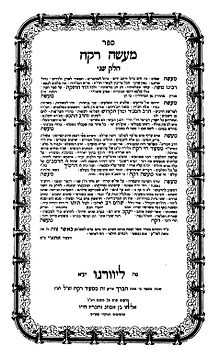Mas'ud Hai Rakkah
| Hakham Mas'ud Hai Rakkaḥ | |
|---|---|
 Title page of Ma'aseh Rokeaḥ, Volume 2, by Hakham Mas'oud Hai Rakkaḥ | |
| Position | Chief Rabbi and Av Beit Din |
| Organisation | Jewish community of Tripoli |
| Began | 1749 |
| Ended | 1768 |
| Personal details | |
| Birth name | Mas'ud Hai Rakkah |
| Born |
1690 Smyrna, Turkey |
| Died |
July 24, 1768 (age 78) Tripoli, Libya |
| Yahrtzeit | 10 Av 5528 |
| Buried | Tripoli |
| Parents | Aharon Rakkah |
Mas'ud Hai Rakkaḥ (Hebrew: מסעוד חי רקח ,1690 – July 24, 1768),[1] also spelled Raccah, was a Sephardi Hakham and shadar (rabbinical emissary) who led the 18th-century Jewish community of Tripoli, Libya, for 20 years. He was considered one of Libya's leading rabbis and is credited with laying the foundation for that community's development into one of "sages, scribes, and kabbalists".[2] He is the author of Ma'aseh Rokeaḥ (Hebrew: מעשה רקח), a four-volume commentary on Maimonides's Mishneh Torah.
Biography
Mas'ud Hai Rakkaḥ was born in Smyrna, Turkey,[3] the son of Aharon Rakkaḥ.[4] In his youth, he studied under Rabbi Yitzhak Hacohen Rappaport and Rabbi Hayyim Abulafia, developing into a Talmid Chacham of note.[5] He emigrated to Jerusalem with his teacher, Rabbi Rappaport.[4]
When the Jerusalem community experienced difficult economic times, it dispatched shadarim (rabbinical emissaries) to collect funds from the Jewish diaspora. Rakkaḥ was chosen to travel to Jewish communities in North Africa. He set out for Tunisia, Morocco, and Libya, and upon arriving in Tripoli, sent letters to the communities of Venice and Livorno before visiting them as well.[1]
Rakkaḥ arrived in Venice in 1729 and stayed for two years.[3] He next traveled to Livorno, where he served as one of the city's leaders.[3]
The Libyan Jewish community at that time was at a spiritual nadir. Upon Rakkaḥ's return to Tripoli in 1749, the community leaders asked him to stay and lead them. Rakkaḥ agreed and was appointed Av Beit Din (head of the rabbinical court)[1] and Chief Rabbi of Tripoli.[4] He opened a yeshiva in Tripoli and exerted a strong influence on all Libyan Jews.[5] Rakkaḥ was considered one of Libya's leading rabbis.[6] He trained students who became the future hakhamim and dayanim (rabbinical judges) of North African Jewry, including Hakhamim Nathan Adadi (his son-in-law), Shalom Plus, Moshe Lachmish, Binyamin Vatori, and David Tayyar.[3] Rakkaḥ's descendants further built the Libyan Jewish community, including his great-grandson, Abraham Hayyim Adadi, Av Beit Din of Tripoli,[7] and his great-great-grandson, Jacob Rakkah, a leading Sephardi posek (arbiter of Jewish law) and author of approximately 40 sefarim.[8]
Rakkaḥ served the Libyan Jewish community for 20 years until his death on July 24, 1768 (10 Av 5528) at the age of 78.[1] He is buried in Tripoli.[3]
Works
Rakkaḥ saw the publication of the first volume of Ma'aseh Rokeaḥ (Hebrew: מעשה רקח),[9] his novellae and commentary on Maimonides' Mishneh Torah, in Venice in 1742-1743.[5] Volume 2 was published by his great-grandson,[10] Abraham Hayyim Adadi, in Livorno in 1862.[5] Volume 3 was published in Livorno in 1863 by his great-great-grandson, Jacob Rakkah.[5] Volume 4 was published in Jerusalem in 1964 by Rabbi Shmuel Akiva Yaffe-Schlesinger.[5] The inscription on Rakkaḥ's gravestone appears at the beginning of Volume 4.[5]
Rakkaḥ's novellae on the Talmud, commentary on the Five Megillot, and drashot (sermons) remained in handwritten manuscripts, some of which were lost.[5]
Rakkah family
| Aharon Rakkah | |||||||||||||||||||||||||||||||||||||||||||||||
| Mas'ud Hai Rakkah | |||||||||||||||||||||||||||||||||||||||||||||||
| Yitzhak Rakkah | Nathan Adadi | ||||||||||||||||||||||||||||||||||||||||||||||
| Baruh Rakkah | Mas'ud Hai Adadi | ||||||||||||||||||||||||||||||||||||||||||||||
| Shilomo Rakkah | Abraham Hayyim Adadi | ||||||||||||||||||||||||||||||||||||||||||||||
| Jacob Rakkah | Zion Rakkah | Shaul Adadi | |||||||||||||||||||||||||||||||||||||||||||||
| Abraham Rakkah | Meir Rakkah | ||||||||||||||||||||||||||||||||||||||||||||||
References
- ↑ 1.0 1.1 1.2 1.3 Pedetzur, Benetia (26 January 2004). "ר' מסעוד חי רקח זצ"ל" [Rabbi Mas'ud Hai Rakkaḥ, zt"l]. Or Shalom (in Hebrew). Retrieved 25 January 2015.
- ↑ Hallamish, Moshe (2001). הקבלה בצפון אפריקה למן המאה הט"ז : סקירה היסטורית ותרבותית [The Kabbalah in North Africa: A Historical and Cultural Survey] (in Hebrew). Tel Aviv: Hakibbutz Hameyuchad. p. 78.
- ↑ 3.0 3.1 3.2 3.3 3.4 "ר' מסעוד חי רוקח" [Rabbi Mas'ud Hai Rakkah]. Shuva Yisrael (in Hebrew). 24 March 2006. Retrieved 25 January 2015.
- ↑ 4.0 4.1 4.2 "Ma'aseh Rokeaḥ Part III". Virtual Judaica. 2010. Retrieved 25 January 2015.
- ↑ 5.0 5.1 5.2 5.3 5.4 5.5 5.6 5.7 "Ma'aseh Rokeaḥ" (in Hebrew). hebrewbooks.org. 2012. Retrieved 25 January 2015.
- ↑ Encyclopaedia Judaica 11. Macmillan. 1971. p. 251.
- ↑ "חכם אברהם חיים אדאדי" [Hakham Abraham Hayyim Adadi] (in Hebrew). HeHakham HaYomi. Retrieved 26 January 2015.
- ↑ "הילולת ר' יעקב רקח זצ"ל" [Hillula of Rabbi Yaakov Rakkaḥ zt"l] (PDF) (in Hebrew). World Organization of Libyan Jews. Retrieved 21 January 2015.
- ↑ The title comes from Exodus 30:25; the second word contains the letters of the author's surname.
- ↑ "Va'Yikra Avraham". Virtual Judaica. 2003. Retrieved 25 January 2015.